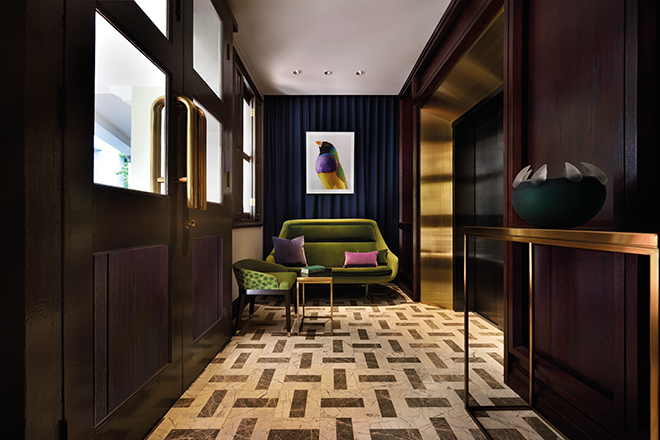Iconic 1900s colonial heritage building, The Club, has begun its next chapter in one of Singapore’s busiest areas thanks to a refurbishment that acknowledges its history and embraces its neighbourhood’s current zeitgeist.
The Club, designed by Singapore design studio Distillery, now part of HASSELL, is a boutique hotel owned by Harry’s International, which occupies three historic corner shophouses on Singapore’s Ann Siang Road.
Reimagined as a collection of five food and beverage venues and 20 guest rooms – each with their own unique style – The Club is a venue that immediately fits into its setting within the vibrant Club Street dining and nightlife precinct.
Though one of the most interesting aspects of The Club, the three different buildings that have combined to make the venue required a great amount of planning and consideration from the design studio.
Paul Semple, HASSELL principal and global head of hospitality, comments: “Three adjoining shop houses have been transformed into this hotel, bringing with it a number of issues in terms of co-ordination, alignment of floor levels and differing ceiling heights, and integration of services such as air conditioning.” All of these issues also had to be fixed within the constraints of a heritage building.
Describing the initial concept for the project Matthew Shang, a fellow principal at HASSEL, says: “I see it as an accumulation of elements, something in all spaces to pique the guest’s interest.” Paul concurs, adding: “We believe that we have delivered on the idea of ‘the club’, giving each element an independent voice yet successfully tying them all together.”
The design studio envisaged a philosophy behind The Club’s design that would ensure it was as welcoming as a members club, while providing the familiarity of home.
“This is, after all, a small hotel of 20 rooms, and instead of seeing this as an obstacle, we saw it as a great opportunity to make a domestic scaled, residential in feel, hotel with the comforts of home. It’s about creating a sense of belonging,” Paul says.
“With all bars and restaurants under the one roof, guests can while away a day or two without having to leave. The bars and restaurants exceed standard hotel offerings, each featuring a distinct personality, and targeted to different times of the day.”
The hotel’s luxurious guest rooms feature furnishings from Bolon, Flos, Bestlite and a vast array of other specialist companies. Throughout the space, guests can find the best quality fabrics from European companies such as Kvadrat and De Gourney deco inspired wallpaper.
The hotel’s restaurants and bars feature many striking pieces, with a striking three storey mural at the entrance to Tiger’s Milk – a feature that Matthew describes as one of his favourite in the project.
In order to accommodate the expanded hospitality venues, the number of guest rooms were reconfigured, allowing The Club to offer more generously proportioned rooms in addition to suites.
“By reducing the number of rooms, we’ve introduced more natural light into the corridors. There’s now a sense of discovery as guests make their way along passageways layered with paintings, sculptures and mementos,” Paul explains.
“Furthermore, no two guestrooms are the same, but the feeling that guests have been invited into someone’s home is consistent across all the guestrooms. A layered design approach combines especially curated and unique artworks, understated luxury and warm materials to complement the building’s heritage.”
The Club’s heritage building setting makes an impact that cannot be ignored, thus the designers worked with the original features to further emphasise the building.
“Singapore conservation guidelines ensure we’ve retained and respected the original façade, and painting the original timber shutters a vibrant red connects it further to its Chinatown location. By drawing the public from Club Streets’ bars, restaurants and clubs into Ann Siang Road, The Club extends the precinct and increases the buzz into the street’s upper side. The Club has successfully breathed new life into an under-utilised establishment in the neighbourhood,” he comments.
Describing HASSEL’s role in the project, Matthew says: “Continuation of a story – enriching what should be an interesting space, which already had a rich history. We see this a simply a part of that continuing life of the building.”
The Club is just one example of how hotels in heritage buildings are gaining a second life through well-considered and sensitive design. In Sydney, the recently opened Ovolo Woolloomooloo at Woolloomooloo Wharf, designed by HASSELL, brings the best of modern design to the harbourside location.



